Impact of manganese on biofilm formation and cell morphology of Candida parapsilosis clinical isolates with different biofilm forming abilities
- PMID: 31403663
- PMCID: PMC6761954
- DOI: 10.1093/femsyr/foz057
Impact of manganese on biofilm formation and cell morphology of Candida parapsilosis clinical isolates with different biofilm forming abilities
Abstract
The commensal species Candida parapsilosis is an emerging human pathogen that has the ability to form biofilms. In this study, we explored the impact of the divalent cations cobalt (Co2+), copper (Cu2+), iron (Fe3+), manganese (Mn2+), nickel (Ni2+) and zinc (Zn2+) on biofilm formation of clinical isolates of C. parapsilosis with no, low and high biofilm forming abilities at 30 and 37°C. All strains besides one isolate showed a concentration-dependent enhancement of biofilm formation at 30°C in the presence of Mn2+ with a maximum at 2 mM. The biofilm forming ability of no and low biofilm forming isolates was >2-fold enhanced in the presence of 2 mM Mn2+, while the effect in high biofilm forming isolate was significantly less pronounced. Of note, cells in the biofilms of no and low biofilm forming strains differentiated into yeast and pseudohyphal cells similar in morphology to high biofilm formers. The biofilm transcriptional activator BCR1 has a dual developmental role in the absence and presence of 2 mM Mn2+ as it promoted biofilm formation of no biofilm forming strains, and, surprisingly, suppressed cells of no biofilm forming strains to develop into pseudohyphae and/or hyphae. Thus, environmental conditions can significantly affect the amount of biofilm formation and cell morphology of C. parapsilosis with Mn2+ to overcome developmental blocks to trigger biofilm formation and to partially relieve BCR1 suppressed cell differentiation.
Keywords: BCR1; Candida parapsilosis; biofilm formation; cell morphology; hyphae; manganese; metal ions; pseudohyphae; yeast cells.
© FEMS 2019.
Figures

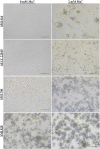
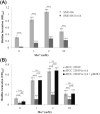

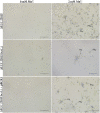
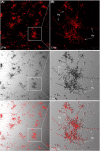
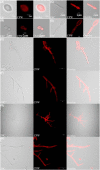

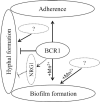
Similar articles
-
Characterization of biofilm formation and the role of BCR1 in clinical isolates of Candida parapsilosis.Eukaryot Cell. 2014 Apr;13(4):438-51. doi: 10.1128/EC.00181-13. Epub 2013 Dec 2. Eukaryot Cell. 2014. PMID: 24297446 Free PMC article.
-
The transcription factor Ndt80 is a repressor of Candida parapsilosis virulence attributes.Virulence. 2021 Dec;12(1):601-614. doi: 10.1080/21505594.2021.1878743. Virulence. 2021. PMID: 33538224 Free PMC article.
-
Conserved and divergent roles of Bcr1 and CFEM proteins in Candida parapsilosis and Candida albicans.PLoS One. 2011;6(12):e28151. doi: 10.1371/journal.pone.0028151. Epub 2011 Dec 1. PLoS One. 2011. PMID: 22145027 Free PMC article.
-
Portrait of Candida Species Biofilm Regulatory Network Genes.Trends Microbiol. 2017 Jan;25(1):62-75. doi: 10.1016/j.tim.2016.09.004. Epub 2016 Oct 4. Trends Microbiol. 2017. PMID: 27717660 Review.
-
Biofilms and vulvovaginal candidiasis.Colloids Surf B Biointerfaces. 2019 Feb 1;174:110-125. doi: 10.1016/j.colsurfb.2018.11.011. Epub 2018 Nov 7. Colloids Surf B Biointerfaces. 2019. PMID: 30447520 Review.
Cited by
-
Nutritional Immunity and Fungal Pathogens: a New Role for Manganese.Curr Clin Microbiol Rep. 2024 Jun;11(2):70-78. doi: 10.1007/s40588-024-00222-z. Epub 2024 Mar 20. Curr Clin Microbiol Rep. 2024. PMID: 40530367 Free PMC article.
-
Iron Metabolism, Pseudohypha Production, and Biofilm Formation through a Multicopper Oxidase in the Human-Pathogenic Fungus Candida parapsilosis.mSphere. 2020 May 13;5(3):e00227-20. doi: 10.1128/mSphere.00227-20. mSphere. 2020. PMID: 32404511 Free PMC article.
-
Influence of Zinc on Histoplasma capsulatum Planktonic and Biofilm Cells.J Fungi (Basel). 2024 May 20;10(5):361. doi: 10.3390/jof10050361. J Fungi (Basel). 2024. PMID: 38786716 Free PMC article.
-
Evaluation of Biofilm Formation in Candida tropicalis Using a Silicone-Based Platform with Synthetic Urine Medium.Microorganisms. 2020 May 1;8(5):660. doi: 10.3390/microorganisms8050660. Microorganisms. 2020. PMID: 32369936 Free PMC article.
References
-
- Araújo D, Henriques M, Silva S. Portrait of Candida species biofilm regulatory network genes. Trends Microbiol. 2017;25:62–75. - PubMed
Publication types
MeSH terms
Substances
LinkOut - more resources
Full Text Sources
Medical

